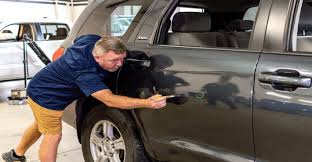Maintaining the pristine condition of your vehicle is not just about aesthetics; it’s also about preserving its value and ensuring its longevity. Among the various issues that can mar the appearance of your car, dents are one of the most common. While they might seem minor, addressing them promptly and correctly is crucial. Here’s a comprehensive guide to understanding dent repair.
Understanding Dent Repair
Dent repair is the process of removing or reshaping a dent in the body of a vehicle. This can involve several methods, each suited to different types of dents and levels of damage. The main goal is to restore the vehicle to its original condition without the need for costly replacements.
Types of Dents
Before diving into the repair methods, it’s essential to understand the different types of dents:
1. Round Dents: Often caused by objects like hailstones or sports balls, these dents are usually small and round.
2. Creased Dents: These occur when a sharp object scrapes along the surface, leaving a noticeable line.
3. Sharp Dents: Caused by contact with pointed objects, these dents have a deep impact.
4. Extensive Damage: Involves large areas of the vehicle’s body and often requires professional attention.
Common Dent Repair Methods
Paintless Dent Repair (PDR)
One of the most popular and cost-effective methods is Paintless Dent Repair. PDR involves reshaping the dented area from the inside out without affecting the paint. This method works best for minor dents where the paint has not been damaged. Professionals use specialized tools to massage the dent back into its original shape.
Traditional Dent Repair
For dents where the paint has been damaged or the metal has been stretched, traditional dent repair is necessary. This method involves filling the dent with a body filler, sanding it down, and then repainting the area to match the rest of the vehicle. It’s a more involved process but essential for significant damage.
DIY Dent Repair Kits
For minor dents, many opt for DIY dent repair kits. These kits typically include a glue gun, dent lifter, and other tools to pull the dent out. While they can be effective for small dents, it’s crucial to follow the instructions carefully to avoid further damage.
The Importance of Professional Dent Repair
While DIY methods can be tempting, professional dent repair offers several advantages. Professionals have the expertise, tools, and experience to repair dents without causing additional damage. They can also ensure that the paintwork is flawlessly matched and the overall integrity of the vehicle is maintained.
Preventing Dents
Prevention is always better than repair. Here are some tips to minimize the risk of dents:
• Park Wisely: Choose parking spots away from other vehicles, shopping carts, and potential hazards.
• Use Car Covers: Protect your car from hail and other elements with a durable car cover.
• Drive Carefully: Be mindful of debris on the road and avoid closely following trucks carrying loose materials.
Conclusion
Dent Repair is an essential aspect of vehicle maintenance that should not be overlooked. Whether you opt for paintless dent repair, traditional methods, or a DIY approach, addressing dents promptly can save you money and keep your car looking great. For extensive damage, always seek professional help to ensure the best results. Remember, maintaining your vehicle’s appearance is not just about pride of ownership but also about protecting your investment.
By understanding the different types of dents and the most effective repair methods, you can make informed decisions that will keep your vehicle in top condition for years to come.
The Ultimate Guide to Dent Repair: Restoring Your Vehicle to Perfection

Categories:
